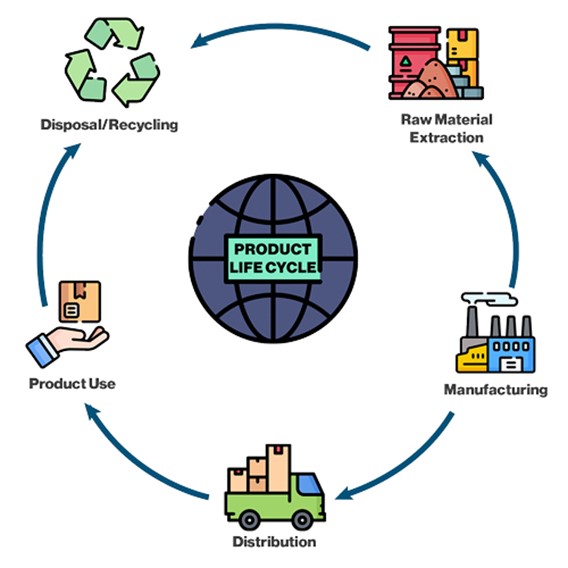What is Life Cycle Assessment (LCA)?
In today's world, where environmental awareness is critical, people and businesses realize the significance of adopting sustainable practices. The Life Cycle Assessment (LCA), or Life Cycle Analysis, is a powerful tool that helps comprehend and enhance the environmental impact of products and processes. This methodology examines the entire life cycle of a product or service, from the extraction of raw materials to disposal, and offers insights into opportunities for sustainable innovation.

|
Figure 1 PRODUCT LIFE CYCLE STAGES
The concept of Life Cycle Assessment (LCA) has been around since the 1960s and 1970s. Its development was driven by increasing environmental concerns and the need for a structured approach to evaluate the environmental impacts of products and processes over their complete life cycle. In 1997, the International Organization for Standardization (ISO) published the first standard for conducting life cycle assessments (LCA), ISO 14040. This standard laid out guidelines and principles for carrying out LCA studies and served as the basis for developing subsequent standards, such as ISO 14044 (2006), which provided more detailed information on the LCA methodology.
What is the Purpose of Life Cycle Assessment?
As environmental issues continue to grow, adopting sustainable practices has become increasingly important. Life Cycle Assessment (LCA) is a comprehensive and holistic approach that considers all stages of a product’s life cycle to assess its sustainability. LCA methodology enables quantification of the environmental impact of a product, which in turn helps to make informed decisions. The main goals of conducting LCA are to promote sustainability and make better environmental decisions.
What are the 4 Phases of Life Cycle Assessment?
The ISO standards ISO 14040 and 14044 describe the four main phases of an LCA:
1. Goal and Scope Definition: It is essential to establish the purpose and scope of the analysis. This involves identifying the environmental aspects being studied and defining clear system boundaries.
2. Inventory Analysis: To effectively manage and analyze resource consumption, emissions, and waste generation, it is essential to gather and quantify all inputs and outputs for each stage of the product life cycle. This means that when an environmental input uses raw materials and energy, the corresponding outputs will include the emission of pollutants and waste streams. Collecting this information can obtain a comprehensive life cycle inventory (LCI) and better understand a product's overall environmental impact.
3. Life Cycle Impact Assessment (LCIA): LCIA involves converting LCI results into impact indicators to evaluate environmental impact. There are 3 significant steps in conducting the assessment.
a. Identify the Impact Categories: The first step is to select relevant impact categories based on the goals and scope of the study. These impact categories are divided into three types: Ecosystem Impacts, Human Impacts, and Resource Depletion. By analyzing a product's or process's consequences throughout its life cycle, we can better understand its overall impact.
b. Classification: Assign the data collected from the life cycle inventory to different impact categories
c. Characterization: Potential impact indicators are calculated.
4. Interpretation / Application: During this phase of the LCA, the inventory analysis and impact assessment results are thoroughly examined, summarized, and presented to stakeholders. The goal is to extract valuable insights from the study that can inform decision-making, pinpoint areas for improvement, and guide actions toward enhancing sustainability.
How many types of Life Cycle Assessment are there?
Life Cycle Assessment (LCA) can be used to evaluate the environmental and, in some cases, social impacts of products or systems. Different types of LCA exist to address specific aspects or perspectives.
• Attributional LCA (ALCA): This assesses a product or system's current or historical environmental impacts, providing a snapshot of environmental performance at a specific time.
• Consequential LCA (CLCA): This evaluates how decisions or interventions impact the system, including changes in production, consumption patterns, or technology adoption.
• Prospective LCA (PLCA): This evaluates a product's or process's environmental impacts in the planning or development phase. The main objective of PLCA is to identify sustainable design strategies early in the development process and integrate eco-friendly practices from the start, ensuring sustainability.
• Retrospective LCA (RLCA): This process involves assessing the environmental impact of a product or process that has already occurred. It requires gathering historical data and analyzing the past effects. This evaluation provides valuable insights into the effectiveness of implemented environmental measures and offers lessons for future improvements.
• Social LCA (SLCA): This type of LCA evaluates the social impacts of a product or process, including aspects such as labor conditions, human rights, and community well-being. It is essential for ensuring a holistic understanding of sustainability.
Different LCA approaches have emerged over the years that allow for flexibility in addressing different sustainability aspects, including Carbon and water Footprinting, Eco-efficiency, Resource efficiency, Input-output, Hybrid LCA, Material Flow Analysis, and Organizational LCA. Choosing the most appropriate type of LCA depends on the sustainability goals of the organization and available data for analysis.
Significance of Life Cycle Analysis:
• Holistic Perspective: LCA provides a comprehensive perspective on environmental impact, preventing the transfer of burdens from one stage to another. This ensures that efforts to minimize the environmental impact are not merely shifted, but genuinely reduced.
• Informed Decision-Making: Businesses can make informed decisions by understanding any significant environmental impact identified through the LCA study. This can help businesses decide on better alternatives to further sustainability.
• Guide Customer Choices: Findings from LCA can be communicated to consumers through labels and declarations, helping them make environmentally friendly decisions. This can also challenge and encourage other businesses to adopt greener practices.
• Policy Support LCA provides a scientific basis for establishing standards and regulations that promote sustainable practices.
Life Cycle Analysis is a crucial tool in achieving sustainability. It provides guidance to businesses, policymakers, and consumers to move towards an eco-friendly future. By implementing the principles of LCA, we can ensure that products and processes are not only profitable but also environmentally sustainable.
Reach out to our regulation experts on chemical and product regulatory compliances



